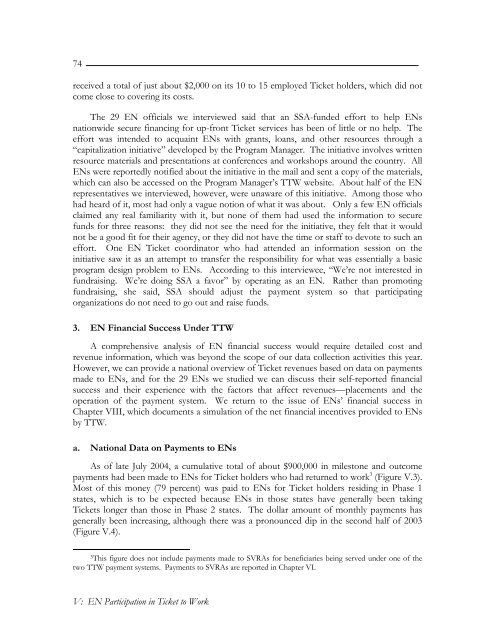Evaluation of the Ticket to Work Program, Implementation ...
Evaluation of the Ticket to Work Program, Implementation ...
Evaluation of the Ticket to Work Program, Implementation ...
Create successful ePaper yourself
Turn your PDF publications into a flip-book with our unique Google optimized e-Paper software.
74received a <strong>to</strong>tal <strong>of</strong> just about $2,000 on its 10 <strong>to</strong> 15 employed <strong>Ticket</strong> holders, which did notcome close <strong>to</strong> covering its costs.The 29 EN <strong>of</strong>ficials we interviewed said that an SSA-funded effort <strong>to</strong> help ENsnationwide secure financing for up-front <strong>Ticket</strong> services has been <strong>of</strong> little or no help. Theeffort was intended <strong>to</strong> acquaint ENs with grants, loans, and o<strong>the</strong>r resources through a“capitalization initiative” developed by <strong>the</strong> <strong>Program</strong> Manager. The initiative involves writtenresource materials and presentations at conferences and workshops around <strong>the</strong> country. AllENs were reportedly notified about <strong>the</strong> initiative in <strong>the</strong> mail and sent a copy <strong>of</strong> <strong>the</strong> materials,which can also be accessed on <strong>the</strong> <strong>Program</strong> Manager’s TTW website. About half <strong>of</strong> <strong>the</strong> ENrepresentatives we interviewed, however, were unaware <strong>of</strong> this initiative. Among those whohad heard <strong>of</strong> it, most had only a vague notion <strong>of</strong> what it was about. Only a few EN <strong>of</strong>ficialsclaimed any real familiarity with it, but none <strong>of</strong> <strong>the</strong>m had used <strong>the</strong> information <strong>to</strong> securefunds for three reasons: <strong>the</strong>y did not see <strong>the</strong> need for <strong>the</strong> initiative, <strong>the</strong>y felt that it wouldnot be a good fit for <strong>the</strong>ir agency, or <strong>the</strong>y did not have <strong>the</strong> time or staff <strong>to</strong> devote <strong>to</strong> such aneffort. One EN <strong>Ticket</strong> coordina<strong>to</strong>r who had attended an information session on <strong>the</strong>initiative saw it as an attempt <strong>to</strong> transfer <strong>the</strong> responsibility for what was essentially a basicprogram design problem <strong>to</strong> ENs. According <strong>to</strong> this interviewee, “We’re not interested infundraising. We’re doing SSA a favor” by operating as an EN. Ra<strong>the</strong>r than promotingfundraising, she said, SSA should adjust <strong>the</strong> payment system so that participatingorganizations do not need <strong>to</strong> go out and raise funds.3. EN Financial Success Under TTWA comprehensive analysis <strong>of</strong> EN financial success would require detailed cost andrevenue information, which was beyond <strong>the</strong> scope <strong>of</strong> our data collection activities this year.However, we can provide a national overview <strong>of</strong> <strong>Ticket</strong> revenues based on data on paymentsmade <strong>to</strong> ENs, and for <strong>the</strong> 29 ENs we studied we can discuss <strong>the</strong>ir self-reported financialsuccess and <strong>the</strong>ir experience with <strong>the</strong> fac<strong>to</strong>rs that affect revenues—placements and <strong>the</strong>operation <strong>of</strong> <strong>the</strong> payment system. We return <strong>to</strong> <strong>the</strong> issue <strong>of</strong> ENs’ financial success inChapter VIII, which documents a simulation <strong>of</strong> <strong>the</strong> net financial incentives provided <strong>to</strong> ENsby TTW.a. National Data on Payments <strong>to</strong> ENsAs <strong>of</strong> late July 2004, a cumulative <strong>to</strong>tal <strong>of</strong> about $900,000 in miles<strong>to</strong>ne and outcomepayments had been made <strong>to</strong> ENs for <strong>Ticket</strong> holders who had returned <strong>to</strong> work 3 (Figure V.3).Most <strong>of</strong> this money (79 percent) was paid <strong>to</strong> ENs for <strong>Ticket</strong> holders residing in Phase 1states, which is <strong>to</strong> be expected because ENs in those states have generally been taking<strong>Ticket</strong>s longer than those in Phase 2 states. The dollar amount <strong>of</strong> monthly payments hasgenerally been increasing, although <strong>the</strong>re was a pronounced dip in <strong>the</strong> second half <strong>of</strong> 2003(Figure V.4).3 This figure does not include payments made <strong>to</strong> SVRAs for beneficiaries being served under one <strong>of</strong> <strong>the</strong>two TTW payment systems. Payments <strong>to</strong> SVRAs are reported in Chapter VI.V: EN Participation in <strong>Ticket</strong> <strong>to</strong> <strong>Work</strong>
















